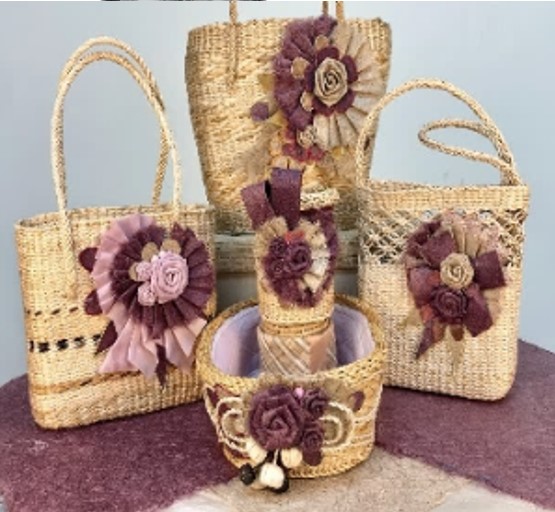การพัฒนาผลิตภัณฑ์จากเส้นใยกล้วยด้วยเทคนิคการย้อมซ้อนสี กรณีศึกษา กลุ่มจักสานจากเชือกกล้วย จังหวัดสงขลา
Main Article Content
บทคัดย่อ
ปัจจุบันการนำแนวคิดเศรษฐกิจหมุนไปปรับใช้กับวิสาหกิจชุมชนยังมีข้อจำกัด การออกแบบสินค้าและผลิตภัณฑ์ยังไม่เป็นไปตามแนวคิดของผลิตภัณฑ์ที่เป็นมิตรกับสิ่งแวดล้อม และการผลิตสินค้าที่ไม่หลากหลาย ดังนั้นงานวิจัยนี้จึงนำเทคโนโลยีและองค์ความรู้ไปใช้ให้เกิดประโยชน์ต่อชุมชนตามความต้องการของชุมชนที่ต้องการพัฒนาคุณภาพของผลิตภัณฑ์สิ่งทอ และพัฒนาผลิตภัณฑ์ให้มีความหลากหลายโดยใช้สีธรรมชาติ โดยมีวัตถุประสงค์เพื่อศึกษาการย้อมเส้นใยกล้วยด้วยสีธรรมชาติ เปรียบเทียบเส้นใยกล้วยที่เพิ่มประจุบวกกับไม่เพิ่ม เพื่อพัฒนาสีม่วง สิรินธรในการย้อมเส้นใยกล้วยด้วยสีธรรมชาติด้วยเทคนิคการย้อมซ้อนสี ผลจากการทดลอง พบว่า การเพิ่มประจุบวก ในการย้อมเส้นใยกล้วยด้วยสีธรรมชาติช่วยให้สีติดมากขึ้น ช่วยเพิ่มความคงทนของสีต่อแสงแดดเทียมในระดับเป็นที่พึงพอใจจากการย้อมสีธรรมชาติเส้นใยที่ได้และสำหรับการย้อมซ้อนสีสามารถพัฒนาให้เกิดสีม่วงสิรินธรที่มีเฉดสีต่างกันอย่างมีนัยสำคัญ โดยไล่ระดับความเข้มของสีจากม่วงครามไปสู่ม่วงแดงตามลำดับ นอกจากนี้นักวิจัยทำการพัฒนาผลิตภัณฑ์จากข้อสรุปของการทดลองโดยสร้างต้นแบบผลิตภัณฑ์ทั้งในรูปเส้นใยกล้วยแบบแผ่นบางทั้งสีธรรมชาติและสีย้อมม่วง รวมถึงถ่ายทอดความรู้สู่ชุมชนสำหรับการพัฒนาอาชีพของคนในพื้นที่จังหวัดสงขลา
Article Details

อนุญาตภายใต้เงื่อนไข Creative Commons Attribution-NonCommercial-NoDerivatives 4.0 International License.
บทความที่ได้รับการตีพิมพ์ในวารสารฯ ท้ังในรูปแบบของรูปเล่มและอิเล็กทรอนิกส์เป็นลิขสิทธิ์ของวารสารฯ
เอกสารอ้างอิง
A. berg and K. H. Magnus, “Fashion on climate: How the fashion industry can urgently art to reduce its greenhouse gas emissions.” McKinsey & Company and Global Fashion Agenda. Accessed: Dec. 19, 2021. [Online]. Available: https://www.mckinsey.com/~/media/mckinsey/industries/retail/our%20insights/fashion%20on%20climate/fashion-on-climate-full-report.pdf
L. Jaroensombut, “Applying the circular economy concept to community enterprises,” Journal of Social Sciences Srinakharinwirot University, vol. 24, no. 1, pp. 145–55, 2021. (in Thai)
P. Rattanachaisit, K. Panpae and T. Srikhirin, “Separation of emusa fibres for textile production,” in The 32nd Kasetsart University Annual Conference, Bangkok, Thailand, Feb. 3-5, 1994, pp. 238–248. (in Thai)
K. Wongkrajang and P. Surayot, “The Effect of Extractions and Mordants on Dyeing Quality and Study the Compound in Mari gold Dye,” Science and Technology Nakhon Sawan Rajabhat University Journal, vol. 9, no. 10, pp. 31–44, 2017. (in Thai)
K. Sakulborisut, S. Kraisuwan and K. Piromthamsiri, “The effect of mordants on the colorfastness of natural brown colored cotton fabric,” Srinakharinwirot University Journal of Science and Technology, vol. 8, no. 15, pp. 1–11, 2019. (in Thai)
C. Kaewklaikhajornsiri and P. Sikkha, “Study of fabric dyeing process of indigo fabrics using banana sap as natural mordant,” Art and Architecture Journal Naresuan University, vol. 3, no. 1, pp. 105–113, 2012. (in Thai)
R. Jhonanan, “Silk fabric dyeing with natural dye from green banana peel (Musa sapientum L.),” M.S. thesis, Dept. Home Economics Technology, Rajamangala University of Technology Thanyaburi, Thailand, 2015. (in Thai)
P. Worachetwarawat and P. Worachetwarawat, “A Study of nonwoven fabric production from Kluai Nang Phaya fiber,” in the 9th Phayao Research Conference, Phayao University, Thailand, Jan. 23-24, 2020, pp. 333–347. (in Thai)
P. Worachetwarawat , P. Worachetwarawat, N. Saengmanee, A. Junsangsri and A. Sukkhung, “A study of the Nang Phaya banana fiber production and dyeing from banana latex,” in the 10th Phayao Research Conference, Phayao University, Thailand, Jan. 25-28, 2021, pp. 911-923. (in Thai)
N. Nachar, “The Mann-Whitney U: A Test for Assessing Whether Two Independent Samples Come from the Same Distribution,” Tutorials in Quantitative Methods for Psychology, vol. 4, no. 1, pp. 13–20, Mar. 2008, doi: https://doi.org/10.20982/tqmp.04.1.p013.
D. C. Montgomery, Design and analysis of experiments, 8th ed. Hoboken, NJ, USA: John Wiley & Sons, Inc., 2013.
B. C. K. Ly, E. B. Dyer, J. L. Feig, A. L. Chien and S. Del Bino, “Research Techniques Made Simple: Cutaneous Colorimetry: A Reliable Technique for Objective Skin Color Measurement,” Journal of Investigative Dermatology, vol. 140, no. 1, pp. 3-12, Jan. 2020, doi: ttps://doi.org/10.1016/j.jid.2019.11.003.


